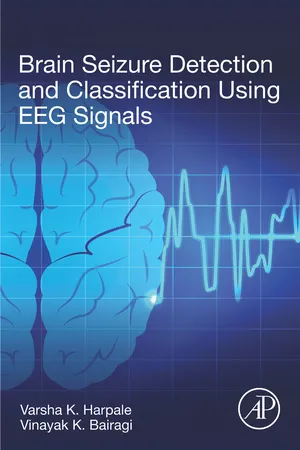
Brain Seizure Detection and Classification Using EEG Signals
- 176 pages
- English
- ePUB (mobile friendly)
- Available on iOS & Android
Brain Seizure Detection and Classification Using EEG Signals
About This Book
Brain Seizure Detection and Classification Using Electroencephalographic Signals presents EEG signal processing and analysis with high performance feature extraction. The book covers the feature selection method based on One-way ANOVA, along with high performance machine learning classifiers for the classification of EEG signals in normal and epileptic EEG signals. In addition, the authors also present new methods of feature extraction, including Singular Spectrum-Empirical Wavelet Transform (SSEWT) for improved classification of seizures in significant seizure-types, specifically epileptic and Non-Epileptic Seizures (NES). The performance of the system is compared with existing methods of feature extraction using Wavelet Transform (WT) and Empirical Wavelet Transform (EWT).
The book's objective is to analyze the EEG signals to observe abnormalities of brain activities called epileptic seizure. Seizure is a neurological disorder in which too many neurons are excited at the same time and are triggered by brain injury or by chemical imbalance.
- Presents EEG signal processing and analysis concepts with high performance feature extraction
- Discusses recent trends in seizure detection, prediction and classification methodologies
- Helps classify epileptic and non-epileptic seizures where misdiagnosis may lead to the unnecessary use of antiepileptic medication
- Provides new guidance and technical discussions on feature-extraction methods and feature selection methods based on One-way ANOVA, along with high performance machine learning classifiers for classification of EEG signals in normal and epileptic EEG signals, and new methods of feature extraction developed by the authors, including Singular Spectrum-Empirical Wavelet
Frequently asked questions
Information
Table of contents
- Cover image
- Title page
- Table of Contents
- Copyright
- Dedication
- Preface
- Acknowledgments
- Chapter 1: Introduction
- Chapter 2: Concepts of EEG analysis and seizures
- Chapter 3: Seizure detection methods and analysis
- Chapter 4: Pattern adapted wavelet-based seizure prediction
- Chapter 5: Effective method for epileptic and nonepileptic seizure classification
- Chapter 6: Concluding remarks and future scope
- Index